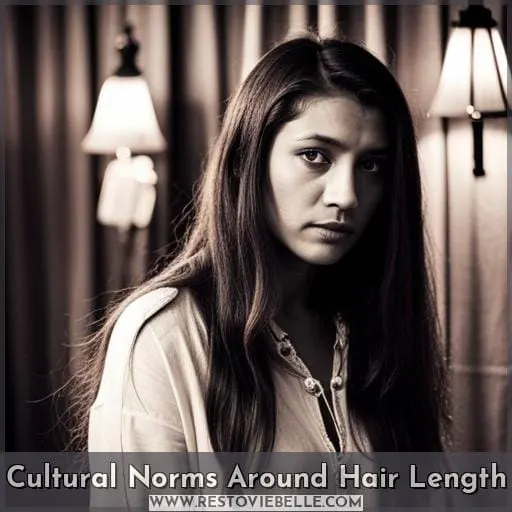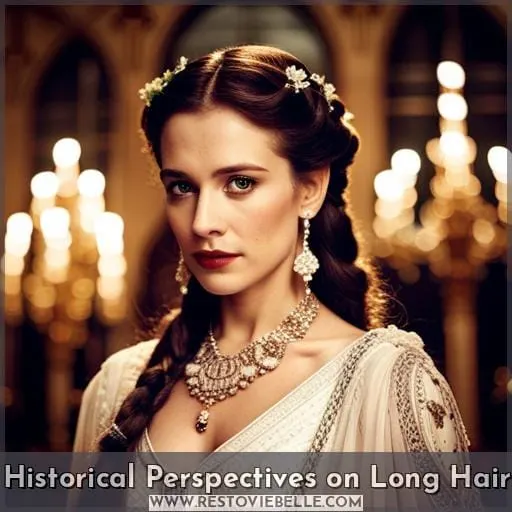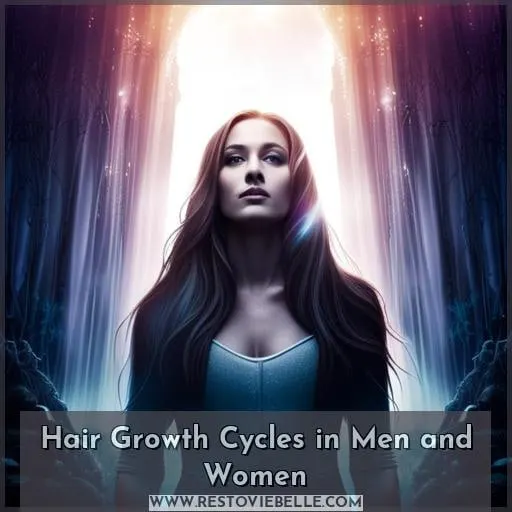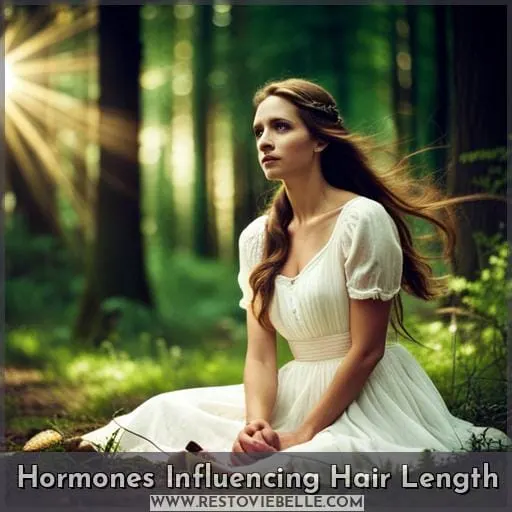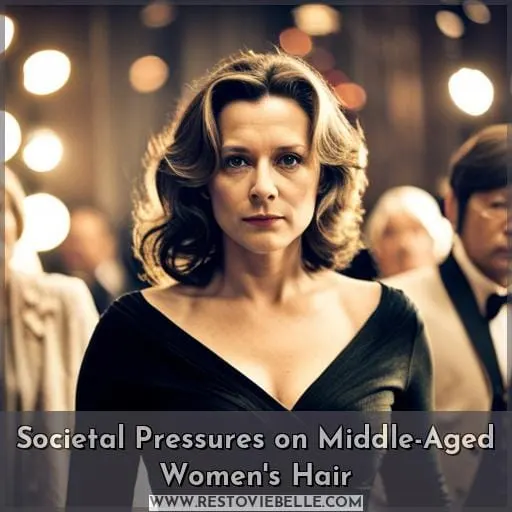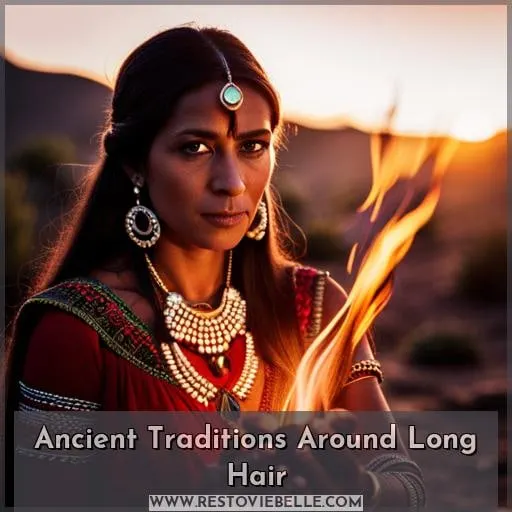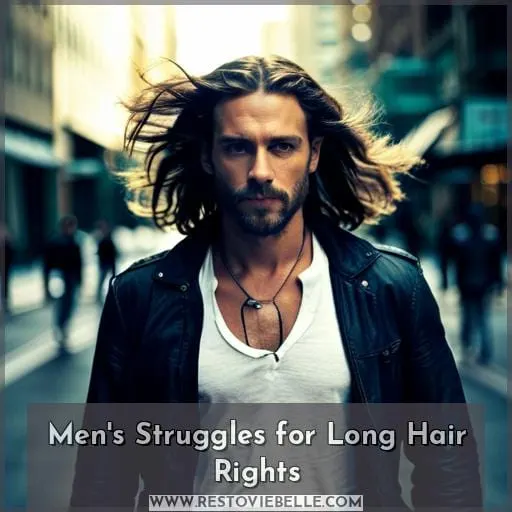This site is supported by our readers. We may earn a commission, at no cost to you, if you purchase through links.
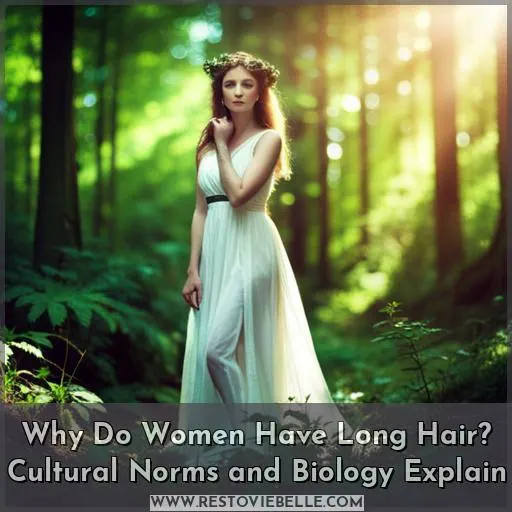 Long hair on women holds complex cultural meanings related to gender, sexuality, and power dynamics.
Long hair on women holds complex cultural meanings related to gender, sexuality, and power dynamics.
Whose gaze do women grow their hair for? What messages do these public yet intimate tresses send? We must unravel the roots of this performative femininity.
Long hair signals youth, beauty, and sexuality. But it also subjects women to the male gaze and societal pressures. As scholars and feminists, we must illuminate the encoded gender dynamics around women’s hair.
Only by examining these complex roots can we understand the cultural meanings behind the meters of hair so many women carry.
Table Of Contents
- Key Takeaways
- Cultural Norms Around Hair Length
- Historical Perspectives on Long Hair
- Biological Factors Promoting Longer Hair in Women
- Hair Growth Cycles in Men and Women
- Hormones Influencing Hair Length
- Societal Pressures on Middle-Aged Women’s Hair
- Experiences of Women With Long Hair
- Ancient Traditions Around Long Hair
- Men’s Struggles for Long Hair Rights
- Sending a Message With Long Hair
- Conclusion
Key Takeaways
- Long hair traditionally signals femininity, beauty, and desirability in women.
- Women’s hair length and style connects to cultural background and personal identity.
- Biological factors like hormones contribute to longer hair growth in women compared to men.
- Societal pressures and judgments influence women’s decisions around hair length as they age.
Cultural Norms Around Hair Length
Our community considers women’s long straight hair a symbol of health, femininity, and conformity to social norms. For centuries, women’s hair has served as a powerful form of communication, conveying various aspects of identity, status, and even legal significance.
A woman’s hairstyle can reflect her cultural background, marital status, age, and social class. Long, flowing hair has traditionally symbolized youth, vitality, and desirability. Societal norms and professional environments often pressure women to cut their hair short once they reach middle-age, as if longer locks are no longer appropriate.
Yet a woman’s choice to keep her hair long can be an act of quiet rebellion, a refusal to bow to arbitrary rules about women’s hairstyles. Her long tresses become a banner, proclaiming her right to personal autonomy and self-expression.
Though cultural norms are ever-evolving, a woman’s hair remains an intimate, storied part of who she is.
Historical Perspectives on Long Hair
Jump on and ride society’s historic hair length rollercoaster: you’ve battled bishops denying blessings, scissors slicing freedom in the ’20s bob, and even fought alongside hippies for long hair rights through the ages.
Throughout history, long hair has carried great significance as a form of gender distinction, self-expression, and rebellion. Societal expectations and religious practices have often promoted short hair, yet the desire for long hair persisted.
From Roman times to the 60s counterculture, long hair movements resisted established norms, sought freedom of identity, and defied authorities who would impose their views.
Though long hair has faced resistance, its endurance reveals an innate human urge for authentic self-expression that transcends arbitrary norms and conventions.
The lengths we go for hair length echo our deep longing for true belonging.
Biological Factors Promoting Longer Hair in Women
As social beings, we seek to understand the biological factors behind the cultural norm of women having longer hair. Research reveals that hormones greatly influence hair growth: estrogen promotes hair growth by lengthening the anagen phase, while testosterone limits growth by shortening this phase, leading to variances between typical male and female hair length.
Hormonal differences between the sexes are key drivers in explaining the divergent hair lengths we observe in males and females across human cultures.
Estrogen Promotes Hair Growth
You feel it brush softly against your back as you move, the estrogen flowing through your body promoting its growth. This hormone nourishes your feminine mane, stimulating each shiny strand from root to tip.
Its nourishing influx enables your tresses to reach extraordinary lengths. Though some still cling to outdated notions, honor the wisdom of your biology. That which nature grows long and strong springs from inner truth. Your hair’s flowing beauty manifests divine blessing, celebrating the glory of womanhood.
– Testosterone Limits Hair Growth
Testosterone can clip the luxuriant tresses you’ve nurtured since girlhood.
- Testosterone shortens the anagen phase of your hair growth cycle.
- It binds to hair follicles receptors, stunting length.
- Your flowing locks whisper of divine wisdom.
- While social norms honor femininity with length.
Though nature gifts women greater growth, your hair speaks beyond chromosomes. Style flows from spirit, cascading with complexity and beauty.
– Hair Growth Phases Vary
Though the anagen phase of hair growth lasts longer for you ladies, both of you still experience the catagen and telogen phases too. The duration of each hair growth phase differs between men and women due to hormonal influences.
| Phase | Women | Men |
|---|---|---|
| Anagen | 2-7 years | 2-5 years |
| Catagen | 2-3 weeks | 2-3 weeks |
| Telogen | 3-4 months | 2-4 months |
While the anagen phase is a bit lengthier for women, the other phases are quite similar. So despite some variations, the hair growth cycle itself is fundamentally the same.
Hair Growth Cycles in Men and Women
Previous views on women’s longer hair stem from nature’s influence. Yet nature’s role extends beyond promoting growth. The cycles governing hair growth differ between genders. For women, the anagen phase, when hair actively grows, lasts years thanks to estrogen’s promotion.
This drawn-out phase enables women’s hair to reach greater length. Unlike men’s hair cycles, women’s anagen aligns with their menstrual cycle; fluctuating hormones prolong growth. With hair expanding around one centimeter monthly, those extra months in anagen let women’s hair reach lengths men’s cannot.
The telogen rest phase is also shortened for women, quickly returning them to anagen. While societal norms press women to have longer hair, nature underlies women’s capacity for it. Women’s bodies synchronize hair and reproduction in ways that inherently enable flowing lengths of hair.
Hormones Influencing Hair Length
Cause hormones like estrogen help your hair grow longer, hun. Them hormones got all up in your follicles determining how long your locks can flow.
- Estrogen extends the anagen (growth) phase so your hair gets extra long.
- Testosterone shortens the anagen phase so men’s hair stays short.
- More estrogen means more hair growth for the ladies.
- Less testosterone means less hair growth for the fellas.
So while them men got their testosterone cutting their hair growth short, you women got that estrogen letting your hair grow out all long and luxurious. Ain’t no shame in what your hormones do naturally, boo. You just embrace that long hair and rock it however you want.
Societal Pressures on Middle-Aged Women’s Hair
You’re facing the shears while the elbow grows out and the calendar pages turn. The societal pressures whisper Shear it short, suggesting long tresses tarnish professional credibility. Yet your hair has been companion through life’s seasons. You stroke your fingers through the strands, remembering times of freedom, intimacy, belonging encoded in those locks.
Though norms declare long hair unseemly for your station, perhaps it’s time to rebel. Refuse society’s shears and keep what’s yours. Flaunt your long flag of refusal, proclaiming your right to choose, defying external forces seeking conformity.
Let your hair speak; whisper your own truths. For in the tangle of those growing strands are tales yet to be told, adventures yet to come.
Experiences of Women With Long Hair
You’ve gotta admit, defying expectations and rockin’ long locks past your prime takes guts. As a woman with long hair, you know the judgments and questions never end. Don’tcha want something more professional? Aren’tcha too old for that? You’ve heard it all.
Societal pressures to cut your hair once you reach a certain age.
Strict professional norms that deem long hair unkempt.
Beauty standards that celebrate youth over wisdom.
Cultural assumptions that long hair makes you less capable.
Every day you face the choice to conform or stay true to yourself. Brushin’ those long strands, you feel beautiful, powerful, and wonderfully woman.
Ancient Traditions Around Long Hair
The glory of your flowing tresses once graced the ancients, yet now society would shear you bare. For the Greeks and Romans, long hair was ideal for both men and women. Your locks were a marker of health, status, and divine blessing.
The church, too, prized long hair as woman’s crowning glory, a sign of obedience to God’s design.
| Ancient Culture | Gender Ideals | Hairstyle |
|---|---|---|
| Greek | Long hair for both | Flowing, adorned |
| Roman | Long, center-parted | Ornate styles |
| Biblical | Long hair as glory | Loose, uncut |
Yet standards shift. Your flowing hair once embodied virtue; now it invites scorn. You must battle expectations and prove your worth beyond the length of your hair. Take heart, beloved sister, and flaunt your tresses boldly. Their length offends only because their beauty exposes society’s narrowness.
Men’s Struggles for Long Hair Rights
Take heart at the tide turning for your personal expression. Throughout history, men seeking to wear their hair long have faced resistance and derision. Archbishop Anselm refused blessings for the long-locked. American men in the mid-20th century endured scorn and suspicion for defying the short hair dictates of the era.
Bold trailblazers persevered against school policies and social conventions restricting male hair length. Their Long Hair Struggles and Hair Length Resistance reflected a yearning for freedom of personal style and identity.
Slowly mentalities shifted, easing Long Hair Battles. Now flowing manes no longer conjure images of rebellion or deprivation of Male Hair Rights. While some still cling to beliefs equating short hair with Historical Hair Fights like church adherence or obedience to God’s design, self-expression triumphs overall.
Take joy in manifesting your truth.
Sending a Message With Long Hair
Hair length has historically carried potent symbolism related to gender, social status, culture, and religion.
Media often uses women’s long hair to convey a traditional feminine ideal.
Women keeping long hair can represent an inner desire for freedom of expression and identity.
Your flowing locks can declare your spirit of independence in this world encouraging strict codes. Yet true equality sees beyond lengths to hearts longing for understanding. What freedom might both genders gain if status symbols no longer divided, and we judged only by character? Then hair could be simply hair, signaling nothing beyond style and self care.
Conclusion
Throughout history and across cultures, social norms dictate women should have flowing locks while men keep it short. Yet biological factors also promote hair growth in women. Estrogen stimulates the hair growth cycle, while testosterone limits it.
Our hormones intrinsically align women with long hair. Though cultural rules play a role, we all express ourselves through our hair, no matter the length. But women often face greater judgment for defying expectations. When we question social conventions and embrace our natural biology, we open new paths of freedom.

